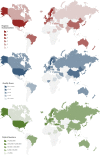Characteristics and Quality of National Cardiac Registries: A Systematic Review
- PMID: 34517724
- PMCID: PMC8452241
- DOI: 10.1161/CIRCOUTCOMES.121.007963
Characteristics and Quality of National Cardiac Registries: A Systematic Review
Abstract
Background: National cardiac registries are increasingly used for informing health policy, improving the quality and cost-effectiveness of patient care, clinical research, and monitoring the safety of novel treatments. However, the quality of registries is variable. We aimed to assess the characteristics and quality of national cardiac registries across all subspecialties of cardiac care.
Methods: Publications relating to national cardiac registries across six cardiac subspecialty domains were identified by searching MEDLINE and the Google advanced search function with 26 438 citations and 4812 full-text articles reviewed.
Results: A total of 155 registries, representing 49 countries, were included in the study. Of these, 45 related to coronary disease or percutaneous coronary intervention, 28 related to devices, arrhythmia, and electrophysiology, 24 related to heart failure, transplant, and mechanical support, 21 related to structural heart disease, 21 related to congenital heart disease, and 16 related to cardiac surgery. Enrollment was procedure-based in 60% and disease-based in 40%. A total of 73.10 million patients were estimated to have been enrolled in cardiac registries. Quality scoring was performed using a validated registry grading system, with registries performing best in the use of explicit variable definitions and worst in assessment of data reliability. Higher quality scores were associated with government funding, mandated enrollment, linkage to other registries, and outcome risk adjustment. Quality scores and number of registries within a country were positively correlated with each other and with measures of national economic output, health expenditure, and urbanization.
Conclusions: There has been remarkable growth in the uptake of national cardiac registries across the last few decades. However, the quality of processes used to ensure data completeness and accuracy remain variable and few countries have integrated registries covering multiple subspecialty domains. Clinicians, funders, and health policymakers should be encouraged to focus on the range, quality, and integration of these registries. Registration: URL: https://www.crd.york.ac.uk/prospero; Unique identifier: CRD42020204224.
Keywords: atrial fibrillation; coronary artery disease; percutaneous coronary intervention; quality of care; registries.
Figures





Comment in
-
Quality of Cardiovascular Registries: Turning the Mirror Around.Circ Cardiovasc Qual Outcomes. 2021 Sep;14(9):e008464. doi: 10.1161/CIRCOUTCOMES.121.008464. Epub 2021 Sep 14. Circ Cardiovasc Qual Outcomes. 2021. PMID: 34517725 No abstract available.
-
Letter by Vermeer et al Regarding Article, "Characteristics and Quality of National Cardiac Registries: A Systematic Review".Circ Cardiovasc Qual Outcomes. 2022 Sep;15(9):e008700. doi: 10.1161/CIRCOUTCOMES.121.008700. Epub 2022 Sep 6. Circ Cardiovasc Qual Outcomes. 2022. PMID: 36065812 No abstract available.
-
Response by Dawson et al to Letter Regarding Article, "Characteristics and Quality of National Cardiac Registries: A Systematic Review".Circ Cardiovasc Qual Outcomes. 2022 Sep;15(9):e009257. doi: 10.1161/CIRCOUTCOMES.122.009257. Epub 2022 Sep 6. Circ Cardiovasc Qual Outcomes. 2022. PMID: 36065813 No abstract available.
References
-
- Biswas S, Lefkovits J, Liew D, Gale CP, Reid CM, Stub D. Characteristics of national and major regional percutaneous coronary intervention registries: a structured literature review EuroIntervention. 2018; 14:1112–1120. doi: 10.4244/EIJ-D-18-00434 - PubMed
-
- Hickey GL, Grant SW, Cosgriff R, Dimarakis I, Pagano D, Kappetein AP, Bridgewater B. Clinical registries: governance, management, analysis and applications Eur J Cardiothorac Surg. 2013; 44:605–614. doi: 10.1093/ejcts/ezt018 - PubMed
-
- Emilsson L, Lindahl B, Köster M, Lambe M, Ludvigsson JF. Review of 103 Swedish healthcare quality registries J Intern Med. 2015; 277:94–136. doi: 10.1111/joim.12303 - PubMed
-
- Cameron PA, Gabbe BJ, Cooper DJ, Walker T, Judson R, McNeil J. A statewide system of trauma care in Victoria: effect on patient survival Med J Aust. 2008; 189:546–550. doi: 10.5694/j.1326-5377.2008.tb02176.x - PubMed
-
- Jakobsen E, Green A, Oesterlind K, Rasmussen TR, Iachina M, Palshof T. Nationwide quality improvement in lung cancer care: the role of the Danish lung cancer group and registry J Thorac Oncol. 2013; 8:1238–1247. doi: 10.1097/JTO.0b013e3182a4070f - PubMed
Publication types
MeSH terms
LinkOut - more resources
Full Text Sources
Medical

